Management Task Force

|
|
|
W3C Face To Face |
|
01/22/03 |
|
Management Task Force
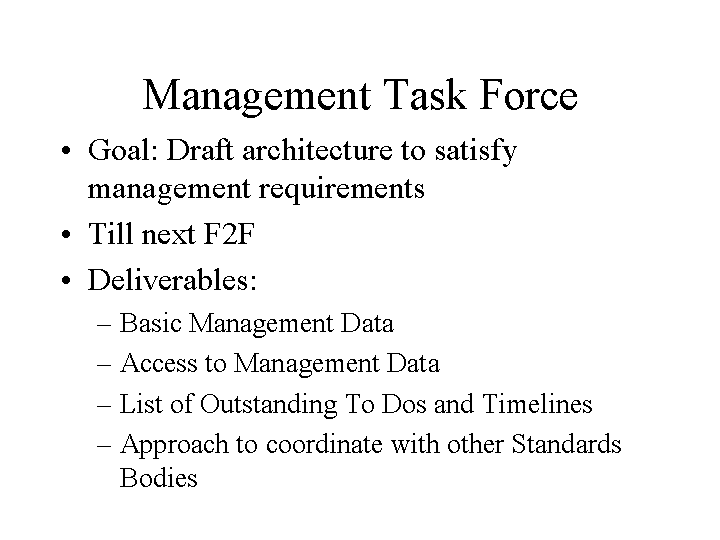
|
|
|
|
Goal: Draft architecture to satisfy
management requirements |
|
Till next F2F |
|
Deliverables: |
|
Basic Management Data |
|
Access to Management Data |
|
List of Outstanding To Dos and
Timelines |
|
Approach to coordinate with other
Standards Bodies |
|
Participants and Progress
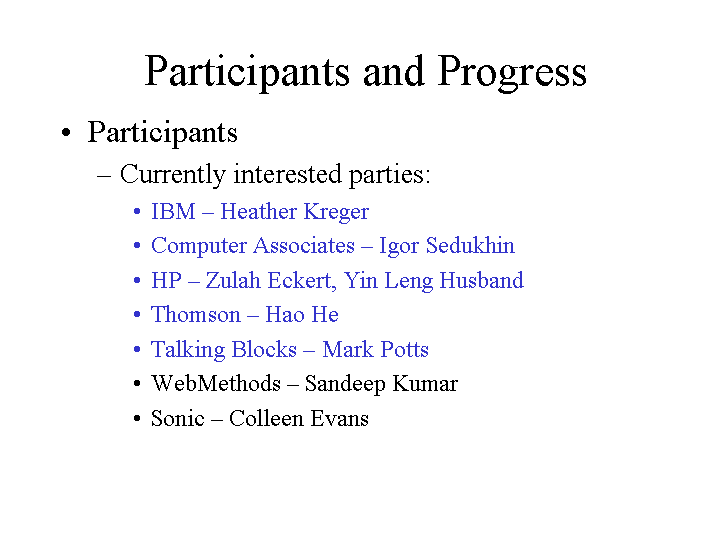
|
|
|
|
|
Participants |
|
Currently interested parties: |
|
IBM - Heather Kreger |
|
Computer Associates - Igor Sedukhin |
|
HP - Zulah Eckert, Yin Leng Husband |
|
Thomson - Hao He |
|
Talking Blocks - Mark Potts |
|
WebMethods - Sandeep Kumar |
|
Sonic - Colleen Evans |
|
W3C WSAWG's role
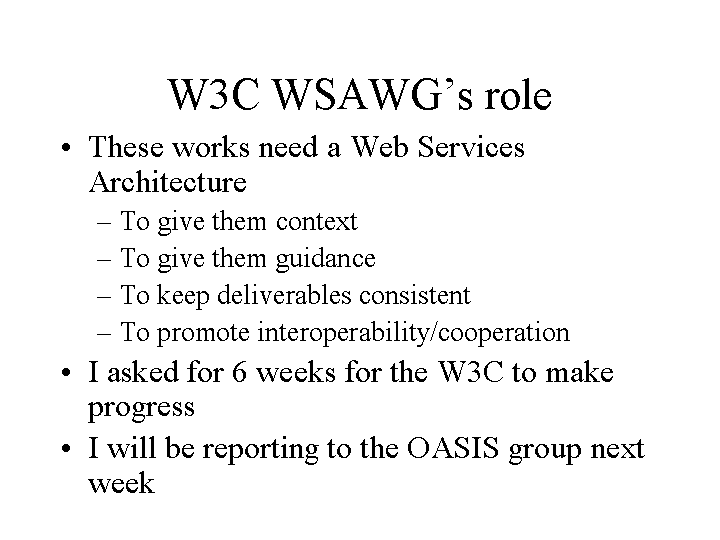
|
|
|
|
These works need a Web Services
Architecture |
|
To give them context |
|
To give them guidance |
|
To keep deliverables consistent |
|
To promote
interoperability/cooperation |
|
I asked for 6 weeks for the W3C to make
progress |
|
I will be reporting to the OASIS group
next week |
|
|
|
Outside Forces
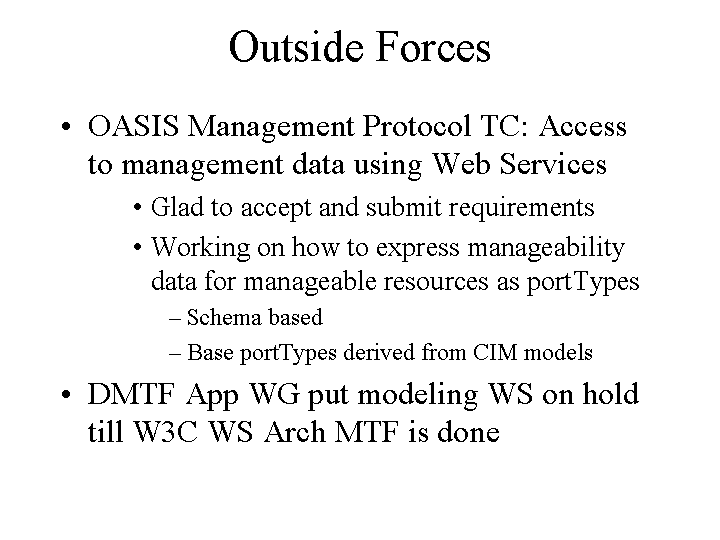
|
|
|
|
|
|
OASIS Management Protocol TC: Access to
management data using Web Services |
|
Glad to accept and submit
requirements |
|
Working on how to express manageability
data for manageable resources as portTypes |
|
Schema based |
|
Base portTypes derived from CIM
models |
|
DMTF App WG put modeling WS on hold till
W3C WS Arch MTF is done |
|
Manageable Components
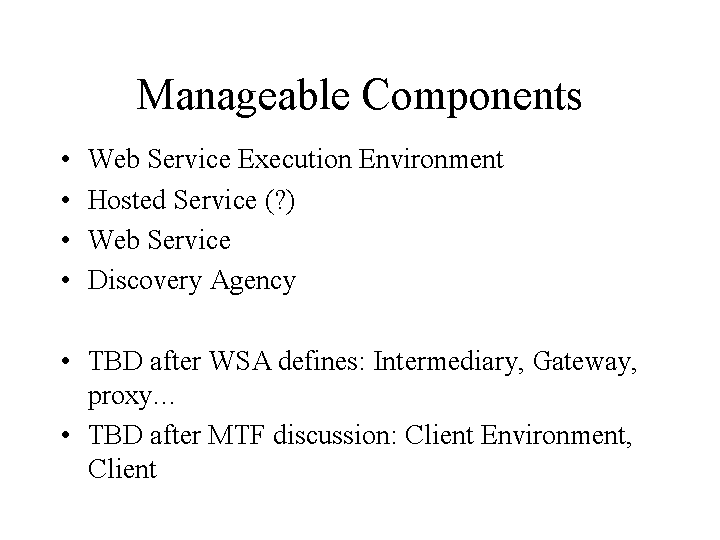
|
|
|
Web Service Execution Environment |
|
Hosted Service (?) |
|
Web Service |
|
Discovery Agency |
|
|
|
TBD after WSA defines: Intermediary,
Gateway, proxy… |
|
TBD after MTF discussion: Client
Environment, Client |
|
Review

|
|
|
|
For each component (reaching consensus
on requirements in each category) |
|
Information (Identification, etc) |
|
Configuration |
|
Metrics |
|
Operations |
|
Events |
|
Access to manageability |
|
Accessible via WSA |
|
Discovery |
|
Of manageable components and relationships via WSA |
|
Of manageability capabilities of
components via WSA |
|
Of Relationships from manageable
components |
|
|
|
Progress
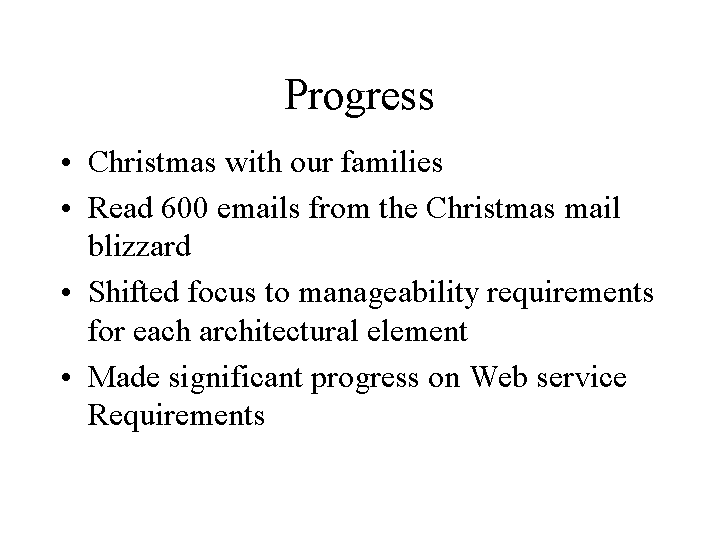
|
|
|
Christmas with our families |
|
Read 600 emails from the Christmas mail
blizzard |
|
Shifted focus to manageability
requirements for each architectural element |
|
Made significant progress on Web service
Requirements |
|
|
|
Work in progress
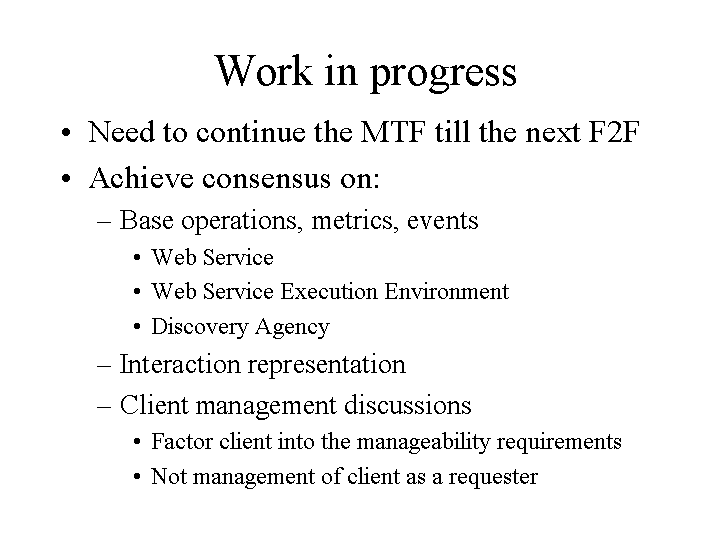
|
|
|
|
|
Need to continue the MTF till the next
F2F |
|
Achieve consensus on: |
|
Base operations, metrics, events |
|
Web Service |
|
Web Service Execution Environment |
|
Discovery Agency |
|
Interaction representation |
|
Client management discussions |
|
Factor client into the manageability
requirements |
|
Not management of client as a
requester |
|
Deliverables
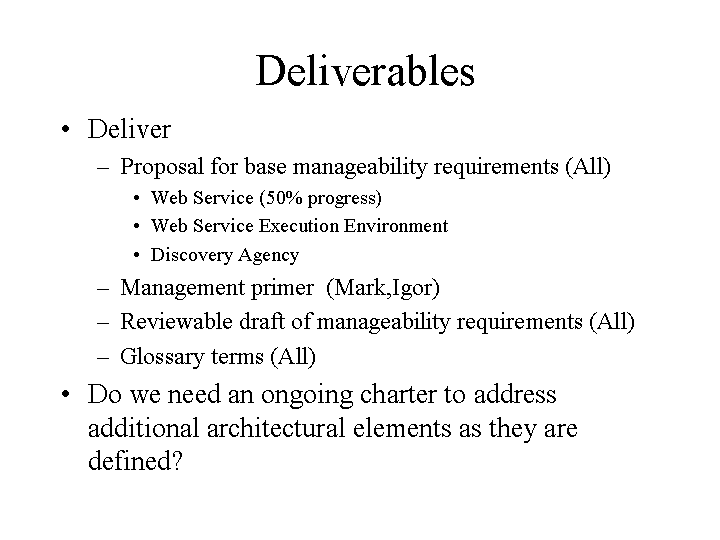
|
|
|
|
|
Deliver |
|
Proposal for base manageability
requirements (All) |
|
Web Service (50% progress) |
|
Web Service Execution Environment |
|
Discovery Agency |
|
Management primer (Mark,Igor) |
|
Reviewable draft of manageability
requirements (All) |
|
Glossary terms (All) |
|
Do we need an ongoing charter to address
additional architectural elements as they are defined? |
|
Next Steps
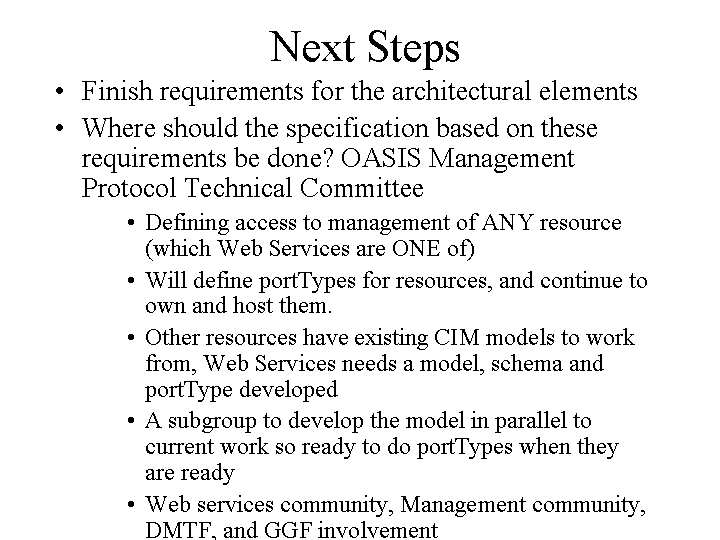
|
|
|
|
|
Finish requirements for the
architectural elements |
|
Where should the specification based on
these requirements be done? OASIS Management Protocol Technical
Committee |
|
Defining access to management of ANY
resource (which Web Services are ONE of) |
|
Will define portTypes for resources, and
continue to own and host them. |
|
Other resources have existing CIM models
to work from, Web Services needs a model, schema and portType
developed |
|
A subgroup to develop the model in
parallel to current work so ready to do portTypes when they are
ready |
|
Web services community, Management
community, DMTF, and GGF involvement |
|
Example Data: Service Environment
Not consensus on this yet
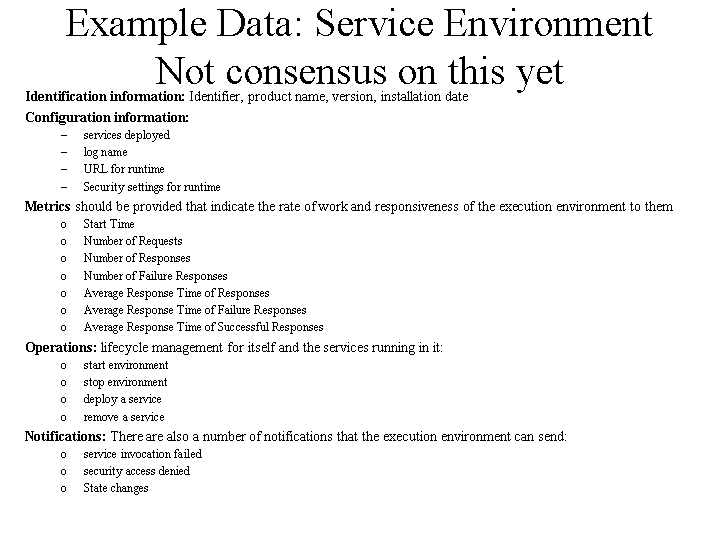
|
|
|
|
Identification information: Identifier,
product name, version, installation date |
|
Configuration information: |
|
services deployed |
|
log name |
|
URL for runtime |
|
Security settings for runtime |
|
Metrics should be provided that indicate
the rate of work and responsiveness of the execution environment to
them |
|
Start Time |
|
Number of Requests |
|
Number of Responses |
|
Number of Failure Responses |
|
Average Response Time of Responses |
|
Average Response Time of Failure
Responses |
|
Average Response Time of Successful
Responses |
|
Operations: lifecycle management for
itself and the services running in it: |
|
start environment |
|
stop environment |
|
deploy a service |
|
remove a service |
|
Notifications: There are also a number
of notifications that the execution environment can send: |
|
service invocation failed |
|
security access denied |
|
State changes |
|
Example Data: Web Service
No Consensus on this yet
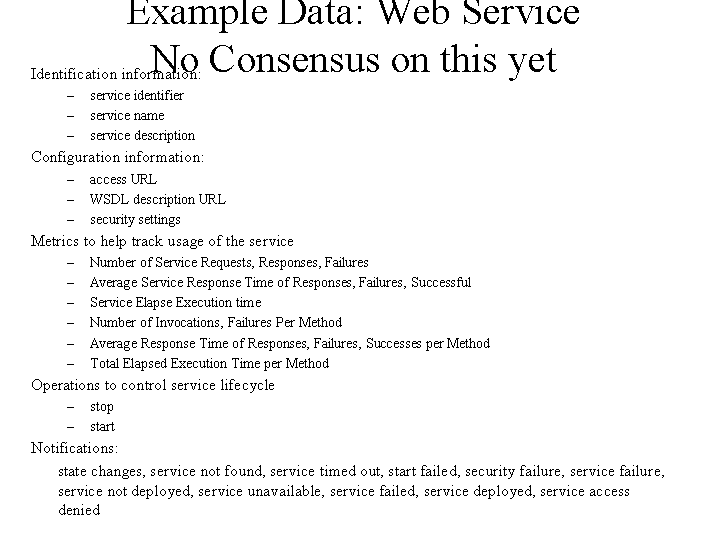
|
|
|
|
Identification information: |
|
service identifier |
|
service name |
|
service description |
|
Configuration information: |
|
access URL |
|
WSDL description URL |
|
security settings |
|
Metrics to help track usage of the
service |
|
Number of Service Requests, Responses,
Failures |
|
Average Service Response Time of
Responses, Failures, Successful |
|
Service Elapse Execution time |
|
Number of Invocations, Failures Per
Method |
|
Average Response Time of Responses,
Failures, Successes per Method |
|
Total Elapsed Execution Time per
Method |
|
Operations to control service
lifecycle |
|
stop |
|
start |
|
Notifications: |
|
state changes, service not found,
service timed out, start failed, security failure, service failure,
service not deployed, service unavailable, service failed, service
deployed, service access denied |
|
|
|
Example Data:Discovery Agency

|
|
|
|
Identification information: |
|
product name,version,install
date,maintenance level, instance name for instance, URL |
|
Configuration information: |
|
configuration file, replication period,
nodes |
|
Metrics: that will help operators gauge
its responsiveness and usage (demarked with where the data must
come from): |
|
the rate of accesses, startTime |
|
number of invokes per operation (get,
find, publish, publish entity, publish relationship) |
|
average response time per operation
(get, find, publish etc) |
|
percentage of request failure
responses |
|
summary metrics :# of businesses,
services, relationships |
|
Operations: |
|
start, stop, smartPing, backup trace
on/off, replicate (start, cancel, nodes, period), reset metrics,
manageUser(find, manage, email) |
|
Events: Degraded, running out of space,
failure for percentage of messages,
overloaded runtime, about to fail, resource availability failure,
has failed, resource failure, security access failures (decrypt,
authentication, signature verification failures, authorization of
users) |
|